Attacks on trains: what the numbers say
Terrorists see public surface transportation as a killing field; despite their continuing obsession with attacking commercial aviation, when it comes to wholesale killing, trains and buses offer easily accessible concentrations of people

Madrid, 2004: Ten coordinated bombings killed 191 and injured 1,800 // Source: washingtonpost.com
The Mineta Transportation Institute at San Jose State University in San Jose, California, is a research center dedicated to studying all aspects — including security — of ground transportation. A recent study — Brian Michael Jenkins and Bruce Robert Butterworth, “Explosives and Incendiaries Used in Terrorist Attacks on Public Surface Transportation: A Preliminary Empirical Examination” (San Jose, California: Mineta Transportation Institute, March 2010) — examines patterns in attacks on trains since the mid-1990s. Here are some of its findings:
- Method of attacks on trains: Suicide bombers may not be the greatest threat against trains. The suicide method of delivering a bomb (“carried on person”) is more lethal than average, but so are bombs concealed in passenger compartments or in parcels or bags. Data on the other aspects of bombs placed on trains are roughly the same as those for all bomb attacks against all targets.
- Distribution and lethality by target: Attacks on passenger and subway trains dominate distribution and, except for attacks on tourist trains (which are relatively rare), also are the most lethal train attacks. These figures reflect the Madrid and London attacks, showing the effect of recent and major attacks on overall lethality.
- Distribution and lethality by device: The overall lethality of explosive and incendiary devices — often used in enclosed areas — is greater than average. Unspecified IEDs are more lethal in train attacks than in all bomb attacks, and not only do they dominate distribution, they are the only device with above-average lethality for such attacks.
- Distribution and lethality by delivery and concealment method: The most frequent method of concealment of bombs is placement in passenger compartments (31.8 percent), then placement on tracks (25.1 percent), then concealment or placement in stations (21.2 percent). Other methods with more than 10 recorded attempts include leaving bombs in parcels or bags (7.8 percent), placing a bomb (or VBIED) outside of a station (5.3 percent), and finally, suicide bombers (4.15 percent). The rest of the methods have been used fewer than 10 times in events in the database. Thus, concealment methods for trains have about the same distribution as that for all bomb attacks.
- The most notable difference between lethality in train bomb attacks and that in all bomb attacks is that concealing a bomb in the passenger compartment of a train or in a bag or parcel is about as lethal as a suicide bombing.
- The twelve most lethal combinations: The twelve most lethal combinations of target, device, and delivery and concealment method for passenger train targets (for example, the 2007 Peace Train attack in India, the dynamite bombing in China, and the female suicide bomber in the Moscow subway) are not necessarily the most commonly used. Attacks against tourist trains are rare (with an average lethality of 8 fatalities per attack [FPA]), and the unknown attacks include one particularly lethal attack against a train station in Sri Lanka (5 FPA) in which the attackers used a method that is not described in the source material. The methods of concealment and delivery that are used most commonly or that have been used in particularly notorious attacks include the following:
- The most lethal method that has been used in more than 10 attacks is concealment of bombs in parcels or bags in passenger trains, yielding a fatality per device (FPD) of 13, higher than that of the suicide bombings. This method was used in the Madrid subway bombings.
- Suicide bombing was used in the 2003 attack on a commuter train in Moscow (12 FPD), and also in the three London subway bombs on 7 July 2005 (11 FPD) and attacks in India, China, Sri Lanka, Israel, Turkey, and Indonesia that yielded a relatively low FPD of 3.
- The most commonly used concealment methods for train attacks are placement of a bomb in the passenger compartment, used in 118 attacks in the database (6 FPD), and placement of a bomb in the station, used in 66 attacks (5 FPD). These data derive from a large enough number of attacks to be particularly relevant.
